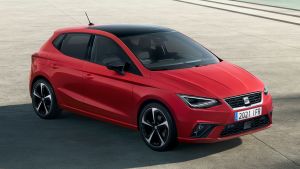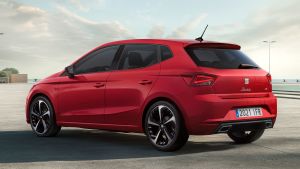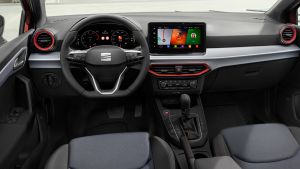L
Luke Wilkinson
Guest
A facelifted version of the SEAT Ibiza supermini has been launched. The revised supermini features a range of technology improvements and some minor styling updates, which the Spanish brand hopes will keep it competitive with the likes of Ford Fiesta and Hyundai i20.
Styling changes on the outside for the updated Ibiza are few and far between. Buyers can choose from two new paint colours (Sapphire Blue and Asphalt Blue), while a new SEAT badge features on the car’s radiator grille. There’s also a new “Ibiza” nameplate on the hatchback’s tailgate, finished in the same handwritten script as the latest Leon.
SEAT has also introduced three new alloy wheel designs as part of the update. There’s two new 17-inch options for the supermini’s FR, Xcellence and Xcellence Lux trims, and one new 18-inch option for the FR Sport specification.
The rest of SEAT’s revisions are limited to equipment upgrades. Every version of the Ibiza now comes with LED headlights as standard, with SE and SE Technology models receiving the firm’s Eco LED lamps, and FR models upwards getting SEAT’s full LED units.

SEAT Ibiza facelift - front

SEAT Ibiza facelift - rear

SEAT Ibiza facelift - dash
Revisions for the Ibiza’s interior are more noticeable. The old car’s centre-mounted infotainment systems have been replaced by a pair of floating-style units, measuring either 8.25 inches on the entry-level model or 9.2 inches for SE Technology variants and up.
Some new air vents occupy the space left by the old infotainment screens, and SEAT has retrimmed the rest of the dashboard in a softer touch plastic. Every model also gets a new multifunction steering wheel, while FR Sport and Xcellence models receive a 10.25-inch digital instrument cluster.
The new infotainment systems have brought a host of technology updates with them, such as wireless Apple CarPlay and Android Auto and a new voice recognition system. The latter system is activated using the voice command “Hola Hola” and allows the driver to enter navigation instructions or search for music without taking their eyes off the road.
Elsewhere in the cabin, SEAT has equipped some new LED ambient lighting, with the driver and passenger air vents now lighting up with a specific colour depending on the trim-level. SE models get honey-coloured lighting, and FR and Xcellence variants get red or burgundy lights.

SEAT Ibiza facelift - front

SEAT Ibiza facelift - rear

SEAT Ibiza facelift - dash
SEAT has also fitted an eSIM to the Ibiza, meaning it now supports the firm’s SEAT Connect smartphone app. The system allows drivers to remotely lock and unlock the car’s doors, as well as check its fuel level and parking location. There’s also a function which activates the car’s horn and hazards, so the owner can find their car more quickly in a busy car park.
Buyers get some extra safety equipment, too, such as lane assist, traffic sign recognition, high-beam assist and side assist, which warns the driver when a vehicle gets within 70 metres of the car’s blind spots. SEAT has also fitted Volkswagen’s Travel Assist semi-autonomous driving system, which can take control of the Ibiza’s steering, brakes and throttle on the motorway under the driver’s supervision.
Like the current car, there’s a trio of 1.0-litre three-cylinder petrol engines to choose from. The entry-level naturally aspirated 79bhp unit and turbocharged 94bhp unit are unchanged. Both come with a five-speed manual gearbox as standard.
However, the Ibiza’s most powerful 1.0-litre engine now produces 5bhp less than the engine it replaces, with an output of 108bhp and 200Nm of torque. It’s available with either a six-speed manual gearbox or a seven-speed dual-clutch automatic.
Now read about SEAT’s upcoming urban EV, which is set to arrive in 2025…
Continue reading...
Styling changes on the outside for the updated Ibiza are few and far between. Buyers can choose from two new paint colours (Sapphire Blue and Asphalt Blue), while a new SEAT badge features on the car’s radiator grille. There’s also a new “Ibiza” nameplate on the hatchback’s tailgate, finished in the same handwritten script as the latest Leon.
SEAT has also introduced three new alloy wheel designs as part of the update. There’s two new 17-inch options for the supermini’s FR, Xcellence and Xcellence Lux trims, and one new 18-inch option for the FR Sport specification.
The rest of SEAT’s revisions are limited to equipment upgrades. Every version of the Ibiza now comes with LED headlights as standard, with SE and SE Technology models receiving the firm’s Eco LED lamps, and FR models upwards getting SEAT’s full LED units.

SEAT Ibiza facelift - front

SEAT Ibiza facelift - rear

SEAT Ibiza facelift - dash
Revisions for the Ibiza’s interior are more noticeable. The old car’s centre-mounted infotainment systems have been replaced by a pair of floating-style units, measuring either 8.25 inches on the entry-level model or 9.2 inches for SE Technology variants and up.
Some new air vents occupy the space left by the old infotainment screens, and SEAT has retrimmed the rest of the dashboard in a softer touch plastic. Every model also gets a new multifunction steering wheel, while FR Sport and Xcellence models receive a 10.25-inch digital instrument cluster.
The new infotainment systems have brought a host of technology updates with them, such as wireless Apple CarPlay and Android Auto and a new voice recognition system. The latter system is activated using the voice command “Hola Hola” and allows the driver to enter navigation instructions or search for music without taking their eyes off the road.
Elsewhere in the cabin, SEAT has equipped some new LED ambient lighting, with the driver and passenger air vents now lighting up with a specific colour depending on the trim-level. SE models get honey-coloured lighting, and FR and Xcellence variants get red or burgundy lights.

SEAT Ibiza facelift - front

SEAT Ibiza facelift - rear

SEAT Ibiza facelift - dash
SEAT has also fitted an eSIM to the Ibiza, meaning it now supports the firm’s SEAT Connect smartphone app. The system allows drivers to remotely lock and unlock the car’s doors, as well as check its fuel level and parking location. There’s also a function which activates the car’s horn and hazards, so the owner can find their car more quickly in a busy car park.
Buyers get some extra safety equipment, too, such as lane assist, traffic sign recognition, high-beam assist and side assist, which warns the driver when a vehicle gets within 70 metres of the car’s blind spots. SEAT has also fitted Volkswagen’s Travel Assist semi-autonomous driving system, which can take control of the Ibiza’s steering, brakes and throttle on the motorway under the driver’s supervision.
Like the current car, there’s a trio of 1.0-litre three-cylinder petrol engines to choose from. The entry-level naturally aspirated 79bhp unit and turbocharged 94bhp unit are unchanged. Both come with a five-speed manual gearbox as standard.
However, the Ibiza’s most powerful 1.0-litre engine now produces 5bhp less than the engine it replaces, with an output of 108bhp and 200Nm of torque. It’s available with either a six-speed manual gearbox or a seven-speed dual-clutch automatic.
Now read about SEAT’s upcoming urban EV, which is set to arrive in 2025…
Continue reading...
